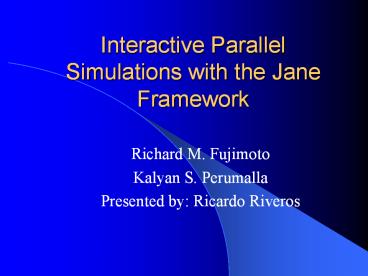Interactive Parallel Simulations with the Jane Framework PowerPoint PPT Presentation
1 / 13
Title: Interactive Parallel Simulations with the Jane Framework
1
Interactive Parallel Simulations with the Jane
Framework
- Richard M. Fujimoto
- Kalyan S. Perumalla
- Presented by Ricardo Riveros
2
Abstract
3 main reasons for the Jane framework
- Graphical user interfaces to support various
phases of the modeling and simulation process - User that do not have access to parallel
computers must be able to access parallel
computing resources elsewhere. - These type of collaborative simulations are
important because expert modelers and parallel
simulation experts may be geographically
dispersed.
3
Introduction
Approaches one must take to implement an ideal
Interface
- Approach 1 The interface must be independent
of the parallel simulation software. - Why ?
- Parallel Simulation Kernels are complex, hence
adding a GUI interface to any part of that
software adds additional complexity. - Language used for Kernel (I.e. C for GTW) may not
be ideal for creating powerful GUIs.
4
Introduction (cont..)
- Approach 2 Simulation models must be
independent of particular views used to visualize
and control the models - Why ?
- Different user can develop different
visualizations of same model. - Approach 3 Nature of the large scale model
development has to be considered. - Why ?
- E.g Many systems used layered approach.
- Approach 4 It is important for interactive
systems to provide factilities for geographically
distributed users to collaborate during model
developments and simulation execution.
5
Overview
- Jane provides default controls and displays
- Jane provides robust and extensible mechanism for
users to provide their own model-specific views - Based on the client-server architecture
6
Jane intended Capabilites
- Remote Control of parallel simulations over the
internet - Default graphical views for runtime
visualizations of modeling systems(TeD) - Easy development of application-specific
animations(such as TeD) - Scripting for programmatic control of parallel
simulations - Pre- and post-simulations analysis of multiple
simulation - Capability to interface with larger design tools
7
Client-Server Architecture for a simulation
seesion in Jane
8
- Jane supports the use of simulation in a larger
design problem - (I.e. network design and optimization) in
which simulation is - just a subcomponent.
- Used for programmatic design of experiments,
automatically - running multiple sequential or concurrent
simulations and for - analysis of simulation results.
- In general, a client can connect to serveral
servers at once, and - a server can run many clients. Several clients
may collaborate - on one simulation
9
Software
- Server (daemon process) written in C
- Client written in Java
- -Simulation display and control
- -TeD or RTI-kit display and
control - -Model-specific display and
control - A model instumentation API in C/C
- Simulation-control and model-specific
visualization API in Java - Communication between clients and servers is via
the TCP protocol and communications between
servers and simulations is via UNIX pipes.
10
Implementation
- Instrumentation
- -the process of augmenting the
otherwise pure model with - additional statements to instruct the
runtime system to - display model-specific views.
- In TeD, instrumentation is supported naturally
using the same event-sending primitives as used
to define the TeD model behavior. Sent over an
STDOUT channel - Events captured by the runtime system and
submitted to Jane client - Using a simple API, the users can define their
own classes that receive the instrumentation
events and overide Jane client display views. - Jane provides the user with default views,
controls and other features common to most
simulations and models. - Categorized into debugging, progress and
performance monitoring, visualization of model,
etc..
11
Synchronization
- Interface between the parallel simulation and
interactive system must address synchronization
issues like time advances and the exchange of
instrumentation data. - In Jane, clients are conservative so no rollbacks
occur. Instrumentation events are sent to Jane
clients using conservative I/O mechanisms of GTW. - So event data from simulation is sent to Jane
clients only when GVT reaches receive-timestamp
of event.
12
Security
- Jane server limits client sessions to 5
- Jane limits the maximum elapsed/CPU time utilized
by any simulation run. - Connections can be denied if they originate from
unauthorized machines.
13
THE END !!!!

